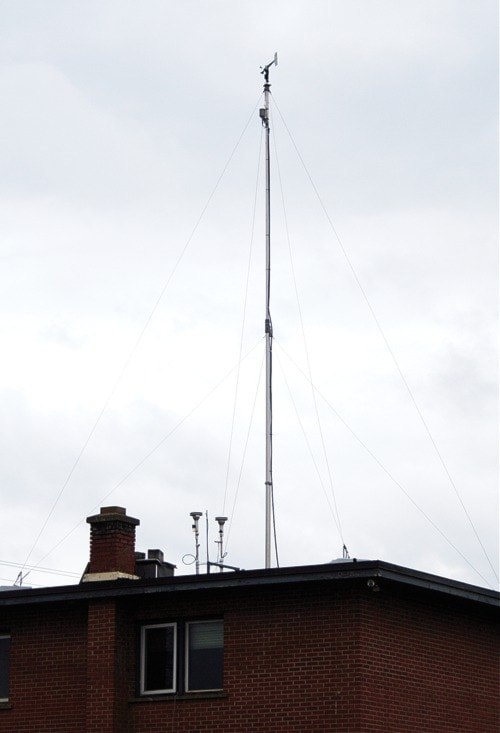Burns Lake's air quality is pretty good.
This, said Ben Weinstein, air quality meteorologist, from the Ministry of Environment, places Burns Lake in the middle of the pack when it comes to air quality.
Air pollution can have environmental, economic and health affects. Weinstein said that poor air quality increases health care costs, limits opportunities for economic growth, and reduces tourism dollars coming in to the community.
It also reduces the quality of life for those living in an area with poor air quality.
He said the pollution level in the Bulkley Valley and Lakes District area is mostly related to the burning of wood, sawmills, pellet plant emissions and industrial emissions.
Other pollution sources include backyard burning, vehicles, trains and road dust.
"Fall and winter are tough times for local air quality," he said, adding that forest fires in summer also account for poor air quality.
"Burns Lake has pretty good air quality and the area is good for fine particles, Fine particulates can get into the lungs and can cause serious health issues."
He said there was a spike in coarse particulates in the air during early spring in Burns Lake and attributed this to cold, dry weather and road dust from sand and gravel laid to restore traction on icy roads.
"There has to be a balance between road traction, which is equally important, and air quality."
In 2008 the province released an air action plan with 28 actions to improve air quality in B.C. including phasing out beehive burners, redeveloping the open burning regulations and the solid fuel burning appliance regulation.
"There is still a lot of work left to do; air pollution persists in Bulkley Valley, Lakes District communities," Weinstein said.
Weinstein is also a member of the Bulkley Valley Airshed Management Society, who, he said are seeking representation for all local governments, either from councillors or municipal planners.
According to Weinstein, widespread local government participation will promote long term solutions by allowing the society to share ideas and tackle issues in a coordinated manner.
A total of 600 old stoves in the Bulkley Valley Lakes District area were changed out during the societies wood stove exchange program that was run in conjunction with municipalities.
He also said that the Village of Burns Lake bylaw which prohibits the use of wood stoves on dust advisory days is a positive.
"Over time air quality has improved in Burns Lake, I wouldn't consider Burns Lake to be threatened from an air quality perspective," he added.
Village of Burns Lake fire chief, Jim McBride said he does not think the air sampling in Burns Lake is a true representation of the local air quality.
He said the monitoring station, which is located on the roof of the Nadina Forest Service Fire Control office [on the corner of Fourth Avenue and Government Street] is between two main roads and is not an accurate sampling of local air.
McBride also asked if previous requests to relocate the monitoring station have amounted to any decision.
Weinstein said there is no current plans to move the station.
"Usually the air in Burns Lake is as bad as the readings," he said.
Mayor Bernice Magee said, "It [the readings] really hurts our reputation."
Weinstein later said to Lakes District News that there are a few reasons why moving the location of the monitoring station is not desirable from the Ministry of Environment’s standpoint.
"In all communities in Skeena Region we have chosen to site air quality monitoring stations in community hot spots; places within a community that experience some of the highest concentrations. The reason for this is that when making air quality management decisions, we want to protect as much of the population as possible. In many cases, these locations correspond to school grounds, such as Burns Lake, where the school [Lakes District Secondary School] is just down the road," he said.
"The hot spot theme was confirmed by UNBC when a grad student organized a program where someone drove around all Bulkley Valley Lakes District communities in a car at night looking for woodsmoke signatures. [According to the findings] the Nadina fire centre is just in the top third as far as concentrations within the community and so fits the bill from a conservative protective standpoint along with a regional continuity standpoint."
Another thing that is required when choosing a monitoring station is an appropriate fetch [needed to eliminate meteorological interference from buildings] and according to Weinstein the fire centre meets this requirement.
"There’s something to be said about data continuity. The devil you know is better than the devil you don’t know. Moving the station to a new location introduces another complex layer of data interpretation and comparison. If a new location were to be chosen, it would be advantageous to have both stations monitoring for a period of time in order to compare the concentrations and get an understanding of how they are different. Given the size of Burns Lake it is unlikely that I could get funding for an additional air quality station in Burns Lake for any period of time and thus my preference is to go with what we’ve got and manage the data accordingly," he added.
Weinstein also said that due to the proximity of the air quality station to Hwy. 16 it does tend to read high road dust concentrations in the spring, however many people live and work near the highway. "Moving the station may lower the concentrations that we monitor but it won’t change those peoples’ exposure," he said.
